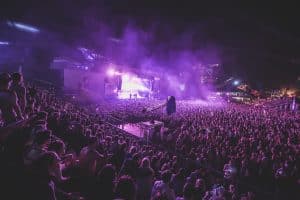Is it really
that black and white? Regardless of all the effort that goes into the brand, promotion, F&B stalls that you personally handpicked, that giant inflatable rubber ducky you had installed, and the dozens of other artists on your roster—the entire success of your music festival rests on the headliner? In many ways, the answer is yes. The headliner can make the event a success as much as it can make it a flop.
Such is especially true for a new or not yet established festival. No matter what you think, the fact is, the headliner defines the festival. It is
the news worthy topic. Case in point: whenever the headliner is announced for Glastonbury, it makes front-page news in British mainstream media. The headliner is the anchor of your festival—the main reason other acts sign up to perform (usually for a reduced fee if not free). It is what will draw more curiosity to your festival and make people delve down deeper into the other acts.
On the flip side, it is also what will stop people from doing just that. If the main act is not the right embodiment of your festival brand, it will not resonate to your audience and will lead them to look elsewhere. Sure, the festival draws music fans into forming a community, but the prestige and draw of the headliner is the ultimate deciding factor for the fans (unless of course, you’ve become a formidable brand such as Coachella, and people just
can’t not attend your festival).
While it’s true that you can’t cater to everyone (because hey, music preferences vary), your headliner needs to reflect your festival’s identity. There is no such thing as a bad act (Nickleback aside), just a
bad headline act for your festival. Choose the wrong band further down the bill, and no one is going to be overly concerned. Commit that mistake for the headline, and you would have derailed the whole festival. Just imagine hiring Justin Bieber as a headliner for a festival full of heavy metal fans—his blood will be on your hands.
 So how exactly do you find the headliner that is right for you?
So how exactly do you find the headliner that is right for you?
In this fast-paced and competitive industry, performers come and go, trends are perpetually changing. Deciding a headliner comes down to you and your business. Just like any other kind of business, it’s about knowing your product and demographic. It boils down to segmentation:
WHAT do you want your brand to become?
WHO is your audience?
If your expertise is country music, and your audience is into country, it’s probably not the best idea to do a hip-hop festival. You’d be surprised how often this simple, logical, miscalculation leads to trouble.
WHERE are you planning to hold the festivals?
Is it in a baseball field, a racetrack, out in the countryside with no infrastructure, or is in city center?
WHEN are you planning on having it?
Another thing to consider are your existing relationships to sponsors and the media—how can you leverage them for your brand? If Coca-Cola is one of your title sponsors, it maybe best not to hire Beyonce as your headliner.
Let me share two personal experiences as examples. The Philippines, a highly Westernized country, has started a music festival uptrend. In its height, I was involved in two development festivals, one in 2014 and another in 2016, and a number of others (though in a more curatorial role). The scopes for the two festivals were very much similar: scope the largest music market possible. One was within the city centre of Manila in 2016, with a Top 40 line-up and a brand persona that demanded everyone’s full, undivided attention. This was one brand that wanted to be heard, one that was commercially competitive and very millennial, to say the least. The headline options listed down on paper after the first brainstorming meeting with the clients would have made Billboard proud.
The other was out in a provincial city in 2014, nearly two hours away from the Metro. Initially, the provincial city posed a few problems logistically, but in the end, it turned out to be more of a pro than a con for the festival. We had to find an appropriate headliner that suited the Westernized market, one that would convince people from the city to travel two hours and stay for the weekend.
There were many contenders for the headline, but finally, we decided on a legendary band that was rumoured to go to the Philippines for years but never made it—at least up until we brought them in. Had we chosen a pop act for this festival, there would have been a number of issues. Transportation, financial capabilities, music market, PR spin, rumours (yes, you read that right), and of course, the audience’s emotional connection to the headliner, were some things we had to take into consideration in order to make the festival a success.
In the end, both festivals turned out to be a success in their own right. The headliners played pinnacle roles in establishing the brands and one of which will be having a second run . Oh, in case you were wondering whom we brought in, it was Kanye West for
Paradise International Music Festival in 2016 and Red Hot Chili Peppers for the
7107 International Music Festival in 2014.
So How Do You Do It?
To start, you must have a clear vision of what your festival is. You must know whom you’re trying to appeal to, what your price points are, and if your target demographic can actually afford it. You also would want to think about what sort of media coverage you want to attain, and what angles to pitch. More than likely, it will be aimed at a certain type of music fans. Naturally, the more types you can reach out to, the more likely you will have a success on your hands.
But on the other hand, by going too wide, by trying to reach out to
too many different types of fans, and
too many genres, you run the risk of trying to provide something for everyone, and in the end pleasing no one and just over-running your budget. You’ve got to make sure your line-up is cohesive and programmed correctly in the end. Music fans that overlap, tend to hit it big—hybrid genres tend to work for the millennials. Music is incredibly polarising, probably more so than anything else that is bought and sold. According to a
Repucom Live Music Sponsorship report, globally 26% of music fans actively dislike heavy metal or heavy rock music. That’s a quarter of your potential market. The same report puts the figures for those disliking rock at 7% and pop at 4%. Simply put, some genres mix, others just don’t.
That is on a global scale. Your festival needs to be approached at a local level, so drill down into local figures, ones that are representative of where you are putting your show on. 51% of Japanese music lovers for example, prefer pop music to all other genres, and of all the countries surveyed came out lowest when it came to electronic music; this can be proven by looking at the line-up of a Fuji Rocks or a Summer Sonic festival. The US was the only country where rock was the most popular (with 58% stating it was their preferred genre)—an Austin City Limits perhaps? If you were putting a festival up in Paris however, you would need to know that the French love electronic/dance music more than anyone else. Similarly, more than 2/3 of US and UK music fans love indie or alternative bands. Glastonbury, Coachella, Lollapalooza are great examples of that fact. That phrase in itself is open to interpretation. REM and Coldplay both fell into that category, and went on to be two of the biggest grossing bands in the world.
The picture gets even more complicated however, when you consider another statistic. The UK is the global leader when it comes to festivals, but even there the number of foreign tourists attending that outnumber both locals and domestic tourists by more than 2 to 1. But is that a case of pandering to the foreign market? Or more a case of the domestic offering being so strong, that people are willing to travel for it? The latter is almost certainly the case in the UK, the US and to a certain extent, Europe, but not so much in Asia. In China for example,
festivals there need to think localisation for success. There, to get a crowd to attend, the local audience would demand both local and foreign artists performing, and visitors from the West would be looking for an alternative experience to what to them, are cookie-cutter festivals around Europe and the States. At the end of the day, after considering all the variables and your market and audience, there are always options for headliners, and ways to creatively manage a line-up. The importance of the headliner needs to be balanced with practicality and priority with the festival.
You wouldn’t launch a new product into a country without knowing the consumer habits of the population, so why on earth would you do it for a festival? So do your research! With the amount of money that is put into mounting a festival, you’ve got to do it right. If you don’t know where to begin, simply seek help from one of the specialized firms like mine (wink wink) that specialize in these things.







